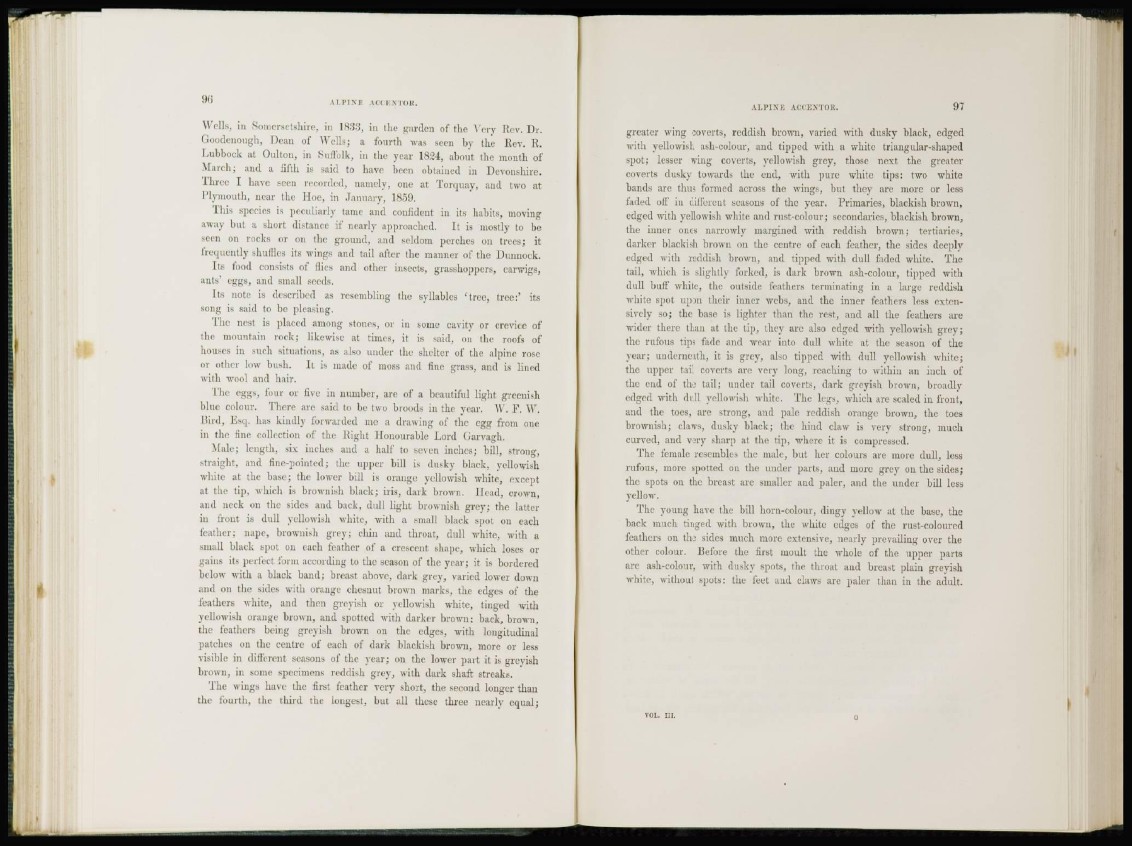
Wells, in Somersetshire, in 1833, in the garden of the Very Rev. Dr.
Goodcnough, Dean of Wells; a fourth was seen by the Rev. R.
Lubbock at Oulton, in Suffolk, in the year 1824, about the month of
March; and a fifth is said to have been obtained in Devonshire.
Three I have seen recorded, namely, one at Torquay, and two at
Plymouth, near the Hoe, in January, 1859.
This species is peculiarly tame and confident in its habits, moving
away but a short distance if nearly approached. It is mostly to be
seen on rocks or on the ground, and seldom perches on trees; it
frequently shuffle- its win^s and tail after the manner of the Dunnock.
I t s food consists of flies and other insects, grasshoppers, earwigs,
ants' eggs, and small seeds.
Its note is described as resembling the syllables 'tree, tree:' its
song is said to be pleasing.
The nest is placed among stones, or in some cavity or crevice of
t he mountain ruck; likewise at times, it is said, on the roofs of
houses in such situations, as also under the shelter of the alpine rose
or other low bush. It is made of moss and fine grass, and is lined
with wool and hair.
The eggs, four or five in number, are of a beautiful light greenish
blue colour. There are said to be two broods in the year. \V. ¥. W.
Bird, Esq. has kindly forwarded me a drawing of the egg f r om o ne
in the fine collection of the Right Honourable Lord Garvagh.
Male; length, six inches and a half to seven inches; bill, strong,
straight, and fine-pointed; the upper bill is dusky black, yellowish
white at the base; the lower bill is orange yellowish wdiite, except
at the tip, which is brownish black; iris, dark brown. Head, crown,
and neck on the sides and back, dull light brownish grey; the latter
in front is dull yellowish white, with a small black spot on each
leal her; nape, brownish grey; chin and throat, dull white, with a
small black spot on each leather of a crescent shape, which loses or
gains its perfect form according to the season of the year; it is bordered
below with a black band; breast above, dark grey, varied lower down
Ut and on the sides with orange chesnut brown marks, the edges of the
feathers white, and then greyish or yellowish white, tinged with
yellowish orange brown, and spotted with darker brown; back, brown,
the feathers being greyish brown on the edges, with longitudinal
patches on the centre of each of dark blackish brown, more or less
visible in different seasons of the year; on the lower part it is greyish
brown, in sonic specimens reddish grey, with dark shaft streaks.
The wings have the first feather very short, the second longer than
the fourth, the third the longest, but all these three nearly equal;
greater wing coverts, reddish brown, varied with dusky black, edged
with yellowish ash-colour, and tipped with a white triangular-shaped
spot; lesser wing coverts, yellowish grey, those next the greater
coverts dusky towards the end, with pure white tips: two white
bands arc thus formed across the wings, but they arc more or less
faded off in different seasons of the year. Primaries, blackish brown,
edged with yellowish white and rust-colour; secondaries, blackish brown,
the inner ones narrowly margined with reddish brown; tertiaries,
darker blackish brown on the centre of each feather, the sides deeply
edged with reddish brown, and tipped with dull faded white. The
tail, which is slightly forked, is dark brown ash-colour, tipped with
dull buff white, the outside feathers terminating in a large reddish
white spot upon their inner webs, and the inner feathers less extensively
so; the base is lighter than the rest, and all the feathers are
wider there than at the tip, they are also edged with yellowish grey;
the rufous tips fade and wear into dull white at the season of the
year; underneath, it is grey, also tipped with dull yellowish white;
the upper tail coverts are very long, reaching to within an inch of
the end of the tail; under tail coverts, dark greyish brown, broadly
edged with dull yellowish white. The legs, which are scaled in front,
and the toes, are strong, and pale reddish orange browu, the toes
brownish; claws, dusky black; the hind claw is very strong, much
curved, and very sharp at the tip, where it is compressed.
The female resembles the male, but her colours are more dull, less
rufous, more spotted on the under parts, and more grey on the sides;
the spots ou the breast are smaller and paler, and the under bill less
yellow.
The young have the bill horn-colour, dingy yellow at the base, the
back much tinged with brown, the white edges of the rust-coloured
feathers on the sides much more extensive, nearly prevailing over the
other colour. Before the first moult the whole of the upper parts
arc ash-colour, with dusky spots, the throat and breast plain grevish
white, without spots: the feet and claws are paler than in the adult.
VOL. III. o